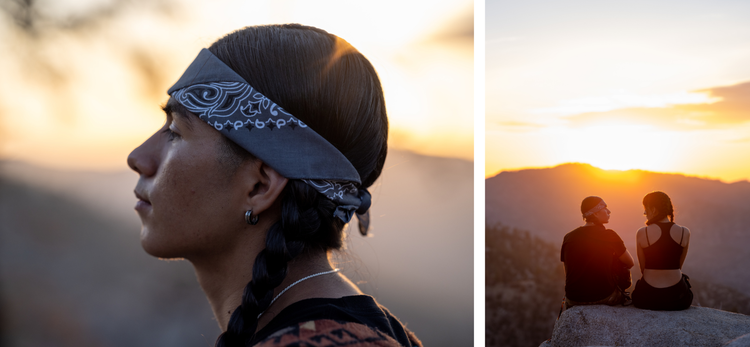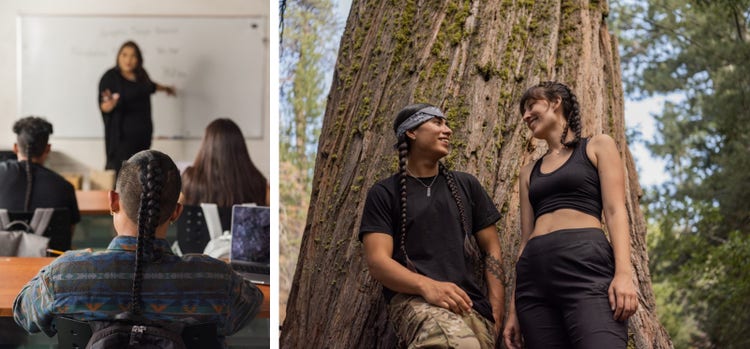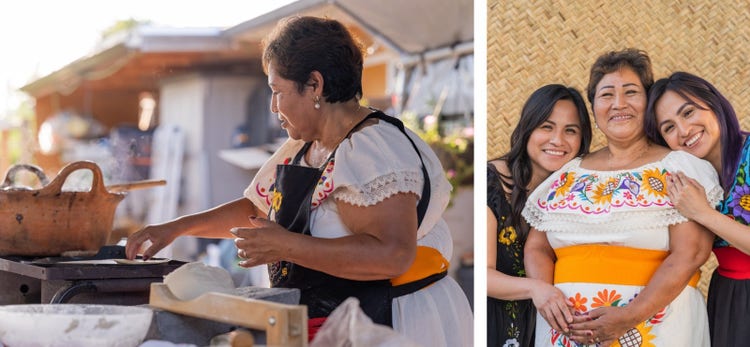In a society that has historically marginalized and flattened perceptions about Indigenous people, visual representation matters. Photography and other visual content can help form new, more authentic narratives by showing the specific and unique nuances of Indigenous peoples’ cultures and lives.
Nawa filmmaker, storyteller, and photographer Tekpatl Kuauhtzin grew up in Los Angeles and graduated with a degree in American Indian studies from UCLA. He sees his passion to create narratives coming from within.
“I think I became a storyteller at birth with my cries,” says Kuauhtzin. “My plan has always been to reforest land and return land to native people.”
A modern tlacuilo striving to reclaim the narrative
Kuauhtzin frames himself as a contemporary version of a tlacuilo — a Nahuatl word meaning notary, scribe, or painter.
“We’re the people in charge of documenting everything, from everyday happenings to cultural ceremonies to the clothes that we would wear,” he says. “Today, I try to do the same thing with video and photo.”
The artist recently partnered with INDÍGENA, a collective agency founded in 2021 with the mission of combining “ancestral knowledge and innovation with a focus on process over output in storytelling to create powerful, purposeful, and intentional creative experiences.”
“INDÍGENA focuses on stories that have not been shown the light of day in the past, for various reasons related to colonization or historical trauma,” says Kuauhtzin. “It’s a modern, contemporary outlet for native and non-native people to tell stories that relate to indigeneity.”
INDÍGENA was founded by Josué Rivas, a photographer and activist of Mexican and Otomi descent, who is also a co-founder of Indigenous Photograph. Adobe Stock has been working with Rivas to better address the ways in which contemporary representation of Indigenous communities is lacking in the stock industry, and how to pro-actively engage with Indigenous artists to support more honest modern visual narratives.
“Since time immemorial, Indigenous peoples have been using visual storytelling as a tool for connection and as a way to see their place in the cosmos,” Rivas told Adobe Stock. “But since the camera came along, images have been used to exploit, create, and perpetuate stereotypes about Indigenous communities. From colonization to extraction of their image, their story has been told from an outsider perspective.”
As Adobe Stock continues to commission new work and put forward calls for stock content from Indigenous creators, collectives like INDÍGENA, and artists like Kuauhtzin and Rivas are positioned to create authentic narratives that capture realistic, diverse, and modern imagery of Indigenous life, ritual, community, and history.
Expanding possibilities for younger generations
For Kuauhtzin, inspiration comes from Indigenous people and his relationship to them as well as his relationships to the land, to himself and his own life, and to people from similar communities. Capturing imagery within Indigenous communities is not just about creating a more authentic record. It’s also about preserving something that will carry into the future.
“For me,” he says, “it’s really about documentation and story-keeping, as way to pass down to future generations.”
But the impact on future generations has implications that go beyond generational knowledge and tradition. By broadening the range of stock imagery that features Indigenous subjects, creators like Kuauhtzin broaden the range of imaginative possibilities for younger generations that look to the world to see what they might become.
Kuauhtzin often works with his partner, Arya Amaya, to create nuanced stories that address Indigenous culture on both the macro and micro level.
“I help develop scientific curriculum that incorporates Western scientific knowledge and Indigenous traditional knowledge systems,” says Arya Amaya, a botanical scientist, seed keeper, and bearer of medicinal knowledge in the tradition of her family. “If we start incorporating our own peoples into those narratives, I think more youth will be inclined to want to become scientists and storytellers.”
“Arya likes to focus on very small details of plants,” says Kuauhtzin. “I just overlook that. I'll keep walking and then she's like, wait, wait, like I want to take a picture of this. There’s this concept in my nation of two energies or two dualities that come together and create one, and that’s how we create beautiful work together.”
“I do work with Tekpatl a lot,” says Amaya. “Having someone who’s very passionate and community-driven and knows how to incorporate our protocols — it's very important.”
We are not a monolith
The US government recognizes 574 tribes with unique cultures, languages, and practices — and there are many other Indigenous communities that are unrecognized. In the 2020 Census, 9.7 million people identified as Native or Indigenous, representing an 85 percent increase over previous years. And yet 95 percent of images that appear in Internet searches of “Native American” are antiquated photos (complete with historical bias) rather than modern-day portrayals. There’s still a tendency to treat native and Indigenous cultures as “vanished” rather than as ever-evolving cultures that continue to thrive despite innumerable challenges to the sovereignty of their people.
“A lot of times in stock photography in particular, when you search ‘Native American’ or ‘Indigenous,’ the results that come up are just inaccurate,” says Kuauhtzin. “We want to show that native people are also doing things with science, native people are also hikers.”
“We try to make sure that the students carry their own traditional knowledge systems, whether that's knowledge of the stars or of the land or of the waters,” says Amaya, “and that no one can take those stories that are passed down to them.”
Separately and together, these artists are driven by a love of their heritage and a desire to carry it forward in an authentic and empowered way.
“I love the sense of wellness that I feel when working with others who have a similar goal of safety, gratitude, and documentation of Indigenous stories,” says Kuauhtzin. “Adobe Stock is giving us an outlet to produce this imagery, and then to share it with the world.”
Explore more work from Tekpatl and INDÍGENA on Adobe Stock. Feeling inspired? Contribute your own images, video, and illustration to Adobe Stock.







